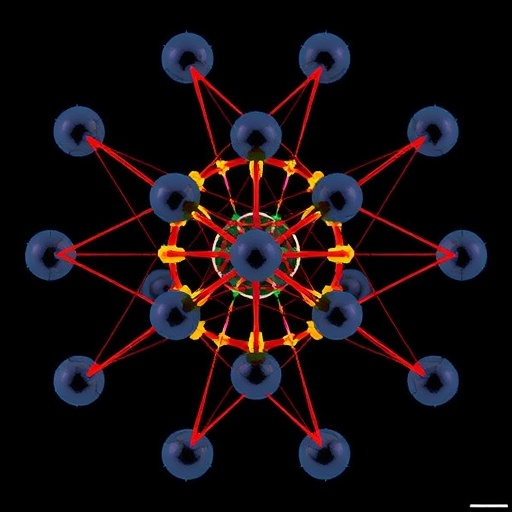In a groundbreaking advancement in the study of topological phenomena, a distinguished team led by Professor Jie Ma from the Institute of Laser Spectroscopy at Shanxi University, China, has successfully observed nonlinear edge states in a novel topological trimer array constructed from interacting ultracold atoms. This pioneering work not only reveals the rich interplay between atomic interactions and topological phases but also sets the stage for a deeper understanding of nonlinear topological physics—a field that has garnered enormous interest across various scientific disciplines, including condensed matter physics and quantum simulation technologies.
At the heart of the study is the innovative synthesis of a topological trimer array, achieved through laser-driven Bragg transitions that manipulate discrete atomic momentum states. By employing this momentum-lattice technique on a Bose-Einstein condensate of 133Cs atoms, the research team has demonstrated precise control over both intra- and inter-cell hopping rates. These adjustments allow for the tuning of interatomic interactions, leading to a versatile framework for exploring how nonlinear effects can alter the dynamics of topologically protected states.
One notable aspect of this research is the distinct observation of nonlinear edge states manifesting during population dynamics within the trimer array. Unlike the behavior observed in conventional nontopological arrays, where transport is typically diffusive across a broad interaction range, the topological trimer array showcased a considerably different response. As the interactions among atoms increased, the localization of atomic density was distinctly concentrated at boundary sites. This phenomenon stands in stark contrast to what was previously understood about atomic transport phenomena in non-topological systems, offering insights into new physical dynamics that emerge solely from the interplay of topology and nonlinearity.
The significance of having the ability to synthetically create such a trimer array cannot be overstated. By enabling the measurement of how different atomic interactions influence the participation ratio—an indicator of how spread out the atomic population is through the states of the system—it allows researchers to probe the essence of topological edge states much more deeply. In their findings, the researchers report the intriguing and surprising formation of nonlinear edge states when the system initializes at two distinct edge states residing in the band gaps of the topological spectrum.
Further examination revealed that for large interaction strengths, the population distribution evolves in such a way that all atoms localize at the initial site when starting from a single-site injection. This phenomenon stands in stark juxtaposition to the behavior seen in either noninteracting or weakly interacting regimes, where the distribution aligns with the contributions from the topological edge states. Through precision measurements and experimental realizations, the team delineates a rich panorama of dynamical regimes that emerge from strong atomic interactions in topological settings.
The implications of these findings extend far beyond just observing new states of matter. By facilitating a deeper understanding of nonlinear topological behaviors, the experiment provides a foundational study that opens new avenues for exploring complex quantum phenomena. As researchers delve further into this burgeoning field, they will also challenge and expand upon established concepts within nonlinear topological photonics, significantly enhancing our understanding of quantum material behaviors under strong interaction conditions.
In their concluding remarks, the research team encapsulated their findings succinctly. They emphasized the transformative potential of their work, asserting that studying the population distribution’s response to varying atomic interactions within the topological trimer array has broader implications for understanding nonlinear topological physics across different systems. Their study not only advances theoretical perspectives but also bridges experimental realities with cutting-edge quantum simulations, highlighting an exciting frontier in atomic and condensed matter physics.
As the research community continues to unravel the complexities of topological states and their interaction with nonlinear dynamics, this study represents a significant milestone. It encourages academics and experimentalists alike to explore the underlying mechanisms that govern these fascinating states of matter, leading potentially to new applications in quantum information science and advanced materials design.
The team’s work, published in the journal Light: Science & Applications, serves as a clarion call for further studies aimed at investigating the emergent properties of topological phases in settings where interaction cannot be ignored. As these insights into nonlinear topological physics continue to advance our knowledge, they will foster a new generation of technologies that leverage these principles, proving that the study of quantum matter is far from complete—it is merely beginning to unravel its vast narrative.
In sum, the intersection of topological physics and atomic interactions, as evidenced in this remarkable study, points to a future rich with potential. The formation of nonlinear edge states in ultracold atomic gases not only enriches our understanding of existing theoretical frameworks but also encourages innovative experimental methodologies that could unveil the quantum wonders held within complex systems. As researchers embark on this exciting journey, the insights gained from this work will undoubtedly pave the way for future explorations in the realm of quantum physics.
Subject of Research: Nonlinear edge states in a topological trimer array of ultracold atoms
Article Title: Observation of nonlinear edge states in an interacting atomic trimer array
News Publication Date: October 2023
Web References: [None available]
References: [None available]
Image Credits: Huiying Du et al.
Keywords: Topological phases, nonlinear edge states, ultracold atoms, Bose-Einstein condensate, atomic interactions, quantum simulation, condensed matter physics, trimer array, momentum lattice technique, population dynamics, participation ratio, nonlinearity in quantum systems.




